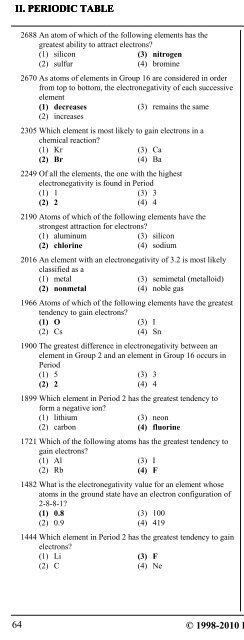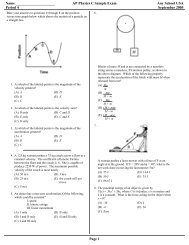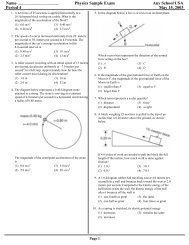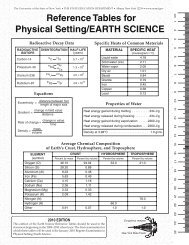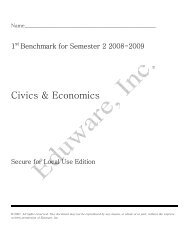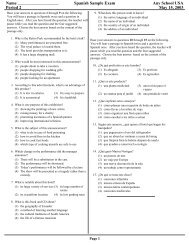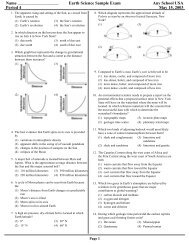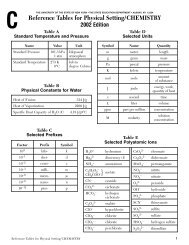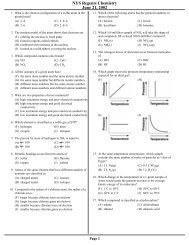Wizard Test Maker - Eduware
Wizard Test Maker - Eduware
Wizard Test Maker - Eduware
- No tags were found...
Create successful ePaper yourself
Turn your PDF publications into a flip-book with our unique Google optimized e-Paper software.
II. PERIODIC TABLE 4. Trends within Groups and PeriodsC. Electronegativity2688 An atom of which of the following elements has thegreatest ability to attract electrons?(1) silicon (3) nitrogen(2) sulfur (4) bromine2670 As atoms of elements in Group 16 are considered in orderfrom top to bottom, the electronegativity of each successiveelement(1) decreases (3) remains the same(2) increases2305 Which element is most likely to gain electrons in achemical reaction?(1) Kr (3) Ca(2) Br (4) Ba2249 Of all the elements, the one with the highestelectronegativity is found in Period(1) 1 (3) 3(2) 2 (4) 42190 Atoms of which of the following elements have thestrongest attraction for electrons?(1) aluminum (3) silicon(2) chlorine (4) sodium2016 An element with an electronegativity of 3.2 is most likelyclassified as a(1) metal (3) semimetal (metalloid)(2) nonmetal (4) noble gas1966 Atoms of which of the following elements have the greatesttendency to gain electrons?(1) O (3) I(2) Cs (4) Sn1900 The greatest difference in electronegativity between anelement in Group 2 and an element in Group 16 occurs inPeriod(1) 5 (3) 3(2) 2 (4) 41899 Which element in Period 2 has the greatest tendency toform a negative ion?(1) lithium (3) neon(2) carbon (4) fluorine1721 Which of the following atoms has the greatest tendency togain electrons?(1) Al (3) I(2) Rb (4) F1482 What is the electronegativity value for an element whoseatoms in the ground state have an electron configuration of2-8-8-1?(1) 0.8 (3) 100(2) 0.9 (4) 4191444 Which element in Period 2 has the greatest tendency to gainelectrons?(1) Li (3) F(2) C (4) Ne1054 As the elements in Period 3 are considered from left toright, they tend to(1) lose electrons more readily and increase in metalliccharacter(2) lose electrons more readily and increase in nonmetalliccharacter(3) gain electrons more readily and increase in metalliccharacter(4) gain electrons more readily and increase innonmetallic character986 As the elements Li to F in Period 2 of the Periodic Tableare considered in succession, how do the relativeelectronegativity and the covalent radius of each successiveelement compare?(1) The relative electronegativity decreases, and the atomicradius decreases.(2) The relative electronegativity decreases, and the atomicradius increases.(3) The relative electronegativity increases, and theatomic radius decreases.(4) The relative electronegativity increases, and the atomicradius increases.599 Within Period 4 of the Periodic Table, which of thefollowing groups contains the element with the highestelectronegativity?(1) 1 (3) 15(2) 2 (4) 17487 In which group of elements do the atoms gain electronsmost readily?(1) 1 (3) 16(2) 2 (4) 18424 Which element in Period 3 has the greatest tendency to gainelectrons?(1) Na (3) Cl(2) Si (4) Ar390 Elements that readily gain electrons tend to have(1) high ionization energy and high electronegativity(2) high ionization energy and low electronegativity(3) low ionization energy and low electronegativity(4) low ionization energy and high electronegativity371 The Group 17 element with the highest electronegativity is(1) fluorine (3) bromine(2) chlorine (4) iodine129 Which atom has the strongest attraction for electrons?(1) Cl (3) Br(2) F (4) I24 Element M has an electronegativity of less than 1.2 andreacts with bromine to form the compound MBr 2. ElementM could be(1) Al (3) Ca(2) Na (4) K64© 1998-2010 <strong>Eduware</strong>, Inc.


